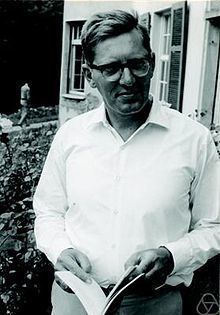Nationality Dutch | Role Mathematician Name Nicolaas de | |
 | ||
Born 9 July 1918The Hague ( 1918-07-09 ) Doctoral students Matheus HautusAntonius LeveltRobert Nederpelt LazaromJohannes RunnenburgStan Ackermans Known for De Bruijn sequenceDe Bruijn indexAutomath Books Asymptotic methods in analysis, Automath: A Language for Mathematics Similar People Paul Erdos, I J Good, Willem Levelt, EM Uhlenbeck | ||
DeBruijn card trick
Nicolaas Govert (Dick) de Bruijn ([nikoːˈlaːs ˈxoːvərt də ˈbrœy̯n]; 9 July 1918 – 17 February 2012) was a Dutch mathematician, noted for his many contributions in the fields of analysis, number theory, combinatorics and logic.
Contents
Biography
Born in The Hague, De Bruijn received his MA in Mathematics at the Leiden University in 1941. He received his PhD in 1943 from Vrije Universiteit Amsterdam with a thesis entitled "Over modulaire vormen van meer veranderlijken" advised by Jurjen Ferdinand Koksma.
De Bruijn started his academic career as at the University of Amsterdam, where he was Professor of Mathematics from 1952 to 1960. In 1960 he moved to the Technical University Eindhoven where he was Professor of Mathematics until his retirement in 1984. Among his graduate students were Johannes Runnenburg (1960), Antonius Levelt (1961), S. Ackermans (1964), Jozef Beenakker (1966), W. van der Meiden (1967), Matheus Hautus (1970), Robert Nederpelt Lazarom (1973), Lambert van Benthem Jutting (1977), A. Janssen (1979), Diederik van Daalen (1980), and Harmannus Balsters (1986).
In 1957 he was appointed member of the Royal Netherlands Academy of Arts and Sciences. He was Knighted with the Order of the Netherlands Lion.
Work
De Bruijn covered many areas of mathematics. He is especially noted for:
He wrote one of the standard books in advanced asymptotic analysis (De Bruijn, 1958).
In the late sixties, he designed the Automath language for representing mathematical proofs, so that they could be verified automatically (see automated theorem checking). Shortly before his death, he had been working on models for the human brain.
Publications
Books, a selection:
Articles, a selection:
